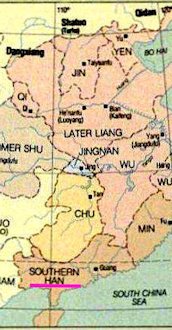
|
Five Dynasties and Ten Kingdoms
Southern Han Kingdom - 917 to 971 - 54 Years
Founding of the Southern Han Liu Yin, was named regional governor and military officer by the Tang court in 905. Though the Tang fell two years later, Liu did not declare himself the founder of a new kingdom as other southern leaders had done. He merely inherited the title of Prince of Nanping in 909. It was not until Liu Yin's death in 917 that his brother, Liu Yan, declared the founding of a new kingdom, which he initially called "Great Yue" 919, but he changed the name to Great Han next year. It was because his surname Liu was the imperial surname of the Han dynasty and he claimed himself a descendant of that famous dynasty. The kingdom is often referred as the Southern Han Dynasty throughout China's history. Territorial extent With its capital at present-day Guangzhou, the domains of the kingdom spread along the coastal regions of present-day Guangdong, Guangxi , Hanoi and the island of Hainan. It not only had borders with the kingdoms of Min, Chu and the Southern Tang, they also bordered the non-Chinese kingdoms of Dali. The Southern Tang occupied all of the northern boundary of the Southern Han after Min and Chu were conquered by the Southern Tang in 945 and 951 respectively. Fall of the Southern Han The Five Dynasties ended in 960 when the Song Dynasty was founded to replace the Later Zhou Dynasty. From that point, the new Song rulers set themselves about to continue the reunification process set in motion by the Later Zhou Dynasty. Through the 960s and 970s, the Song increased its influence in the south until finally it was able to force the Southern Han dynasty to submit to its rule in 971. The last king of Southern Han was Liu Chang, who neglected state affairs to remain in his harem of women, which included Persian girls. Return to Ten Kingdoms Page On to Chu Kingdom ⇨ |